Abstract
Smartphone, integrated with CPU, sensors, network, and storage capability, is developed rapidly in recent years. A cloud-structural health monitoring method based on smartphone was proposed, and a structural health monitoring system Orion-CC, which integrates functions of data acquisition, data analysis and data upload, was developed on smartphone to perform structural health monitoring without any other professional devices. And the feasibility of Orion-CC was proved by the cable force test. A cloud-SHM data sharing website was built to make the data synchronization between smartphone and website, and realize data uploading and sharing, which can improve the efficiency of monitoring and big data integration, make the possibility for big data collection and quick structural safety evaluation.
1. Introduction
Structural health monitoring (SHM) as an effective measure to ensure the safety of large-scale engineering, has been developed rapidly these years [1]. SHM has matured with many advanced techniques. However, some problems should be considered further. First, the object of SHM is typically a piece of important infrastructure, such as large bridge spans, offshore platforms and large dams. However, some structures with less significance may require SHM for safety purposes. Generally, an SHM system is relatively expensive; thus, it is not possible to install SHM systems on every structure. Additionally, SHM systems typically consist of a complex set of various types of sensors, devices and software, which generally requires professional installation and monitoring. Developing a low-cost and convenient monitoring technique will be helpful for the safety maintenance of less significant structures or some special construction procedure for field work [2].
In recent years, smartphones have become popular on an unprecedented scale and can now be used as an effective scientific tool. Rapid development of the smart-phone commercial market has offered the possibility that everyone can carry a mini personal computer that is integrated with sensors, an operating system and communication systems that can be an effective tool for SHM research. Smartphones with an operating system and built-in sensors have already been applied to many fields other than the communication field, including human health monitoring [3], vehicle accident detection [4], and motivation recognition [5-7].
The application of smartphones to SHM has also been validated preliminarily by authors [8], who proposed a new idea for SHM using smartphone’s built-in sensors; their cable force test results indicated that the practicability and accuracy of this approach could satisfy engineering requirements [9, 10]. The authors have established an open website, www.cloudshm.com, which allows anyone to connect to it, upload and share monitoring information. For more rapid disaster evaluation after earthquake, software was also developed to investigate seismic intensities [11]. An application D-Viewer, which can measure the displacement only by one smartphone, has been launched to APP store for free download [12]. All of these applications have shown the feasibility of using smartphones for SHM. The popularity of smartphones presents opportunities for the implementation of a portable SHM system that is compact, low cost, smart phone-based, and intuitive to operate [13-16].
Based on these studies, Orion-CC, an application that integrates data collection and analysis, was developed by the authors to perform a cable force test without any other professional devices; an open website www.cloudshm.com was built to collect monitoring data, make the possibility for big data collection and quick structural safety evaluation.
2. Framework of cloud-SHM
The framework of Cloud-SHM based on smart phone is shown as Fig. 1.
In apperceive control level, structural parameters can be obtained by built-in sensors, such as GPS information, temperature, acceleration, angle, displacement and so on. The interactive interface on smart phone can be applied to the seismic intensity investigation. The monitored data can be uploaded to server or website in network transmission level, and integrated in information integration level. Then the data can be processed to obtain the variation of structural parameters. According to the variation, the structural damage can be evaluated. Then the safety or damage information can be sent to smart phone user, based on the feedback, safety measures can be taken to provide guidance.
Fig. 1Framework of cloud-SHM based on smart phone
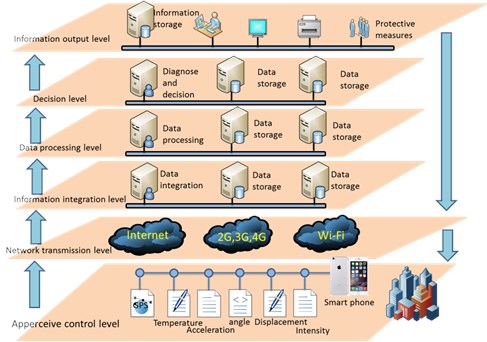
3. Cloud-SHM system Orion-CC
3.1. Design of Orion-CC
Orion-CC was launched by our research group in the Apple App Store, and it is available at the following URL: https://itunes.apple.com/cn/app/orion-cc/id951253417?mt=8. This mobile application makes use of the camera and built-in sensors to collect data, complete data analysis, and obtain parameters needed for the cable force calculation. All the collected data and cable force data can be uploaded to the website www.cloudshm.com by network for data sharing.
3.2. Functions of Orion-CC
Some interfaces of Orion-CC are shown as Fig. 2, (a) is the main interface, and it includes several functions as follows.
1) The collection of current location, for obtaining the location of the monitoring project.
2) The establishment of monitoring project, for building the database of current monitoring. The collecting projects are shown as Fig. 2(b).
3) Data analysis, from which the acceleration time-history curve and frequency spectrum can be obtained. The frequency difference can be obtained by picking up frequency orders, which is shown as Fig. 2(c). And then the cable force can be calculated according to the cable parameters, which is shown as Fig. 2(d).
Fig. 2Some interfaces of Orion-CC
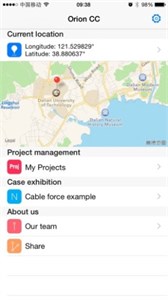
a) Main interface
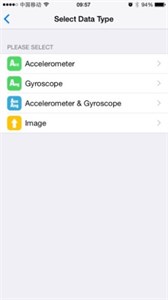
b) Data collection project
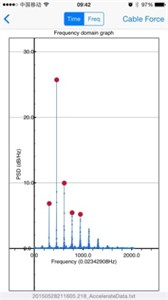
c) Frequency spectrum
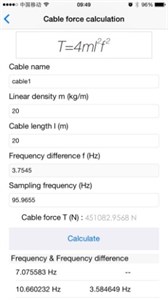
d) Cable force calculation
Fig. 3Log-in interface with account
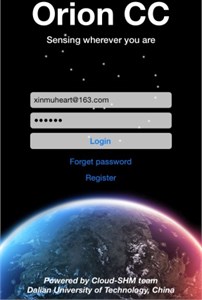
3.3. Network function of Orion-CC
The data can be uploaded to cloud structural health monitoring data sharing platform www.cloudshm.com. A same account is needed to register on website and smart phone. People can build monitoring project by logging in their own account, which is shown as Fig. 3, then goes to the main interface as Fig. 2(a) to complete monitoring.
After the data collection and calculation, the project including GPS information, acceleration, cable force, etc. can be synchronized to website to realize the data sharing.
4. The application on cable force measurement
4.1. Introduction
Vibration method is chosen to measure the cable force. Engineers usually test the cable force on site by exciting a fundamental frequency. In engineering applications, the frequency difference, also known as the adjacent frequency difference, is used as the fundamental frequency. The relationship between the cable force and frequency difference is shown as Eq. (1) (disregarding the effects of stiffness and sag) [17].
where is the linear mass density, is the cable length and is the frequency difference.
4.2. Cable force test on Xinghai Bay Bridge
4.2.1. Field test description
Orion-CC was applied to the cable force test on Xinghai Bay Bridge, and the cable force comparison obtained by Orion-CC and Matlab post-processing to prove the feasibility of Orion-CC.
There are 84 group suspenders on each side, each group includes 2 suspenders, and the elevation of the Xinghai Bay Bridge and suspender number are shown in Fig. 4.
Fig. 4Elevation of Xinghai Bay Bridge

Fig. 5Field photo of suspender 18
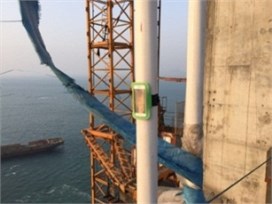
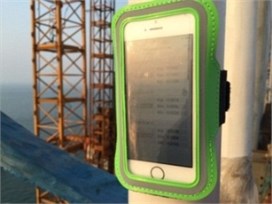
In the field tests, as Fig. 4 shows, suspenders 15-18 in the southwest quadrant are selected for testing using Orion-CC. There are 5 suspenders tested in total: No. 15-17 are one suspender/group and two suspenders in No. 18. One suspender of group 18 is used as an example, and a photo is shown in Fig. 5.
4.2.2. Test results
The test results of the five suspenders, including the frequency differences (natural frequencies) obtained using Orion-CC and Matlab post-processing and the error between them, prove the stability and feasibility of Orion-CC. A comparison is shown in Table 1.
Table 1Frequency difference comparison between Orion-CC and MATLAB
Test time | Method | 15 | 16 | 17 | 18a | 18b | |
Frequency difference (Hz) | 1 | MATLAB | 1.5411 | 1.5450 | 1.4533 | 1.2810 | 1.2680 |
Orion-CC | 1.5405 | 1.5413 | 1.4536 | 1.2801 | 1.2612 | ||
2 | MATLAB | 1.5426 | 1.5375 | 1.4600 | 1.2818 | 1.2630 | |
Orion-CC | 1.5425 | 1.5390 | 1.4651 | 1.2799 | 1.2619 | ||
3 | MATLAB | 1.5402 | 1.5450 | 1.4580 | 1.2818 | 1.2722 | |
Orion-CC | 1.5469 | 1.5413 | 1.4534 | 1.2815 | 1.2698 | ||
Maximum error between two methods in a test | 0.44 % | 0.24 % | 0.35 % | 0.15 % | 0.54 % | ||
Maximum error of Orion-CC in one suspender | 0.66 % | 0.51 % | 0.82 % | 0.12 % | 0.81 % | ||
Maximum error of MATLAB in one suspender | 0.82 % | 0.65 % | 0.68 % | 0.33 % | 0.57 % | ||
As Table 1 shows, the error is very small using the two methods based on MATLAB and Orion-CC in one test. The maximum error of Orion-CC in one suspender is less than 1 %, which shows good repeatability of Orion-CC. Compared with other measurement methods, the reliable, convenient, and quick results are the biggest advantages.
Orion-CC has been launched in the Apple App Store, so anyone can obtain it for free. Moreover, the interactive interface reduces the need for professional training. It can be a valuable tool for an actual engineering application.
5. Cloud-SHM data sharing platform
The using of smart phone makes the field monitoring more convenient, low-cost and high-effective. Moreover, the friendly interface is easy to operate, which makes it acceptable for public people. So people can participate in the structural health monitoring actively, and makes the quick safety evaluation possible, which is impossible by traditional monitoring system. The data collected by smart phone can be synchronized to the cloud-SHM data sharing platform. Combining the strong public participation of the smartphone, the quick large-scale monitoring and evaluation under emergency condition becomes possible.
Fig. 6Monitoring data management on platform
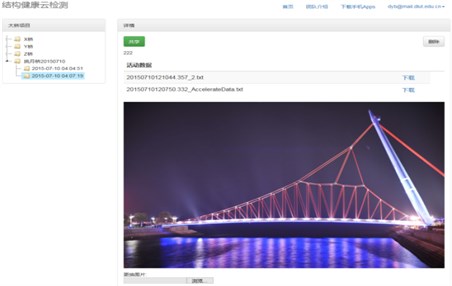
Fig. 7Projects on the platform
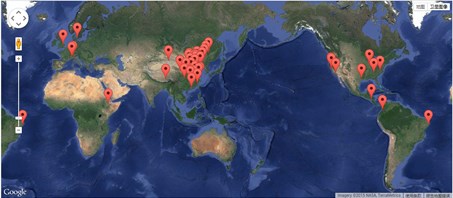
Cloud-SHM data sharing platform supports user registration, the registered users can build main-project and corresponding sub-project by logging in to accomplish data collecting or processing. And then the synchronism function is selected to share data, including image, GPS information, collected data and post-processing information. Users can manage the monitored data by logging in the platform www.cloudshm.com, which is shown in Fig. 6.
The cloud-SHM data sharing platform displays all uploaded project with GPS information, which is shown as Fig. 7. People can get the information easily by checking the map.
6. Conclusion
In this paper, a Cloud-SHM method based on smart phone was proposed, the software Orion-CC was developed and applied to the actual engineering cable force test, which proved the feasibility and convenience. The data sharing platform www.cloudshm.com was built to realize the data integration and safety evaluation. The data collected on Orion-CC can be uploaded on the website, makes the collection of monitoring big data possible. The research on cloud-SHM based on smart phone is the significance supplement for traditional structural health monitoring techniques.
References
-
Yu Y. Wireless Sensors and Their Network Systems for Structural Health Monitoring. Harbin Institute of Technology, Harbin, 2006.
-
Han R. The Exploratory Research on Large-Scale Cloud Monitoring of Civil Engineering Structure Based on Smart Mobile Terminal. Dalian University of Technology, Dalian, 2014
-
Lau S., Konig I., David K., et al. Supporting patient monitoring using activity recognition with a smartphone. 7th International Symposium on Wireless Communication Systems (ISWCS), 2010, p. 810-814.
-
Ketabdar H., Polzehl T. Fall and emergency detection with mobile phones. Proceedings of the 11th International ACM SIGACCESS Conference on Computers and Accessibility, 2009, p. 241-242.
-
Mladenov M., Mock M. A step counter service for Java-enabled devices using a built-in accelerometer. Proceedings of the 1st International Workshop on Context-Aware Middleware and Services: Affiliated with the 4th International Conference on Communication System Software and Middleware (COMSWARE), 2009, p. 1-5.
-
Brezmes T., Gorricho J., Cotrina J. Activity Recognition from Accelerometer Data on a Mobile Phone. Distributed Computing, Artificial Intelligence, Bioinformatics, Soft Computing, and Ambient Assisted Living. Springer, Berlin, Heidelberg, 2009, p. 796-799.
-
Lau S., David K. Movement recognition using the accelerometer in smartphones. Future Network and Mobile Summit, 2010, p. 1-9.
-
Yu Y., Zhao X., Ou J. A new idea: mobile structural health monitoring using smart phones. Third International Conference on Intelligent Control and Information Processing (ICICIP), 2012, p. 714-716.
-
Zhao X., Yu Y., Hu W., et al. Cable force monitoring system of cable stayed bridges using accelerometers inside mobile smart phone. SPIE Smart Structures and Materials + Nondestructive Evaluation and Health Monitoring. International Society for Optics and Photonics, 2015, p. 94351H-94351H-7.
-
Yu Y., Han R., Zhao X., et al. Initial validation of mobile-structural health monitoring method using smartphones. International Journal of Distributed Sensor Networks, 2015.
-
Zhao X., Peng D., Hu W., et al. Quick seismic intensity map investigation and evaluation based on cloud monitoring method using smart mobile phone. SPIE Smart Structures and Materials + Nondestructive Evaluation and Health Monitoring. International Society for Optics and Photonics, 2015, p. 94372A-94372A-7.
-
https://itunes.apple.com/cn/app/d-viewer/id1006583231?mt=8
-
Yu Y., Zhao X., Han R., et al. Design and initial validation of external sensors board of smart phones for mobile structural health monitoring system. Proceedings of the 7th International Conference on Structural Health Monitoring of Intelligent Infrastructure, Politecnico di Torino, 2015.
-
Han R., Zhao X., Yu Y. Convenient posture monitoring on girder hoisting of Dalian Xinghaiwan cross-sea bridge based on smart phone. Proceedings of the 7th International Conference on Structural Health Monitoring of Intelligent Infrastructure, Politecnico di Torino, 2015.
-
Zhao X., Peng D., Hu W., et al. Quick seismic intensity map investigation and evaluation based on cloud monitoring method using smart mobile phone. SPIE Smart Structures and Materials + Nondestructive Evaluation and Health Monitoring. International Society for Optics and Photonics, 2015, p. 94372A-94372A-7.
-
Zhao X., Yu Y., Li M., et al. Research on Cloud-SHM and its applications. Proceedings of the 7th International Conference on Structural Health Monitoring of Intelligent Infrastructure, Politecnico di Torino, 2015.
-
Kim B., Park T. Estimation of cable tension force using the frequency-based system identification method. Journal of Sound Vibration, Vol. 304, Issue 3, 2007, p. 660-676.
About this article
This research was financially supported by key Projects in the National Science and Technology Pillar Program during the Twelfth Five-Year Plan Period (2011BAK02B01) and National Science Foundation of China (51221961).
